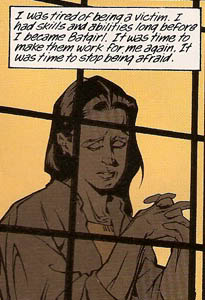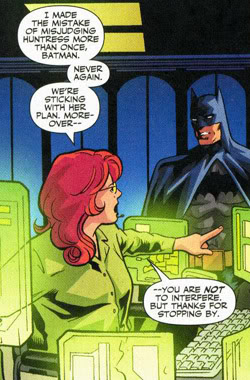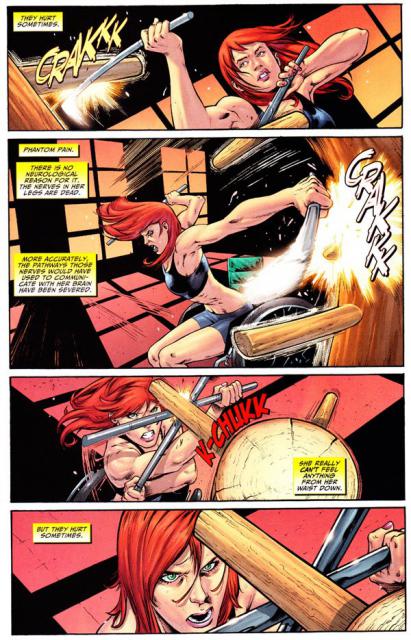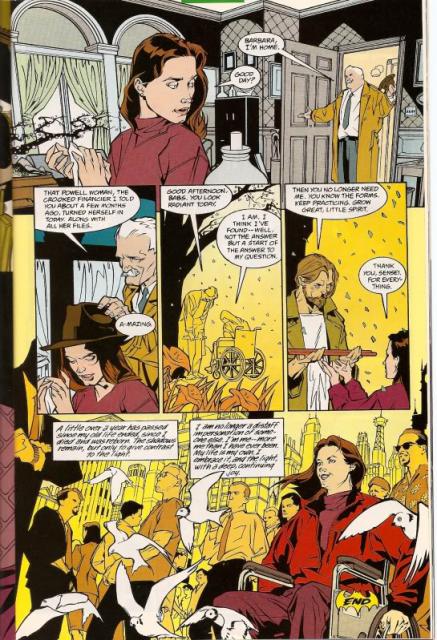Serendip is an independent site partnering with faculty at multiple colleges and universities around the world. Happy exploring!
A Case Study of Disabled Superheroes

A Case Study on Disabled Superheroes
For every disabled person living an unremarkable, everyday life you see in the media, you’ll see at least three disabled people with superpowers. The popularity of the supercrip archetype, whether created through careful media positioning of disabled athletes and personalities, is also visible in the world of popular culture - specifically, mainstream comics. While graphic novels have dealt into emotionally complicated territory with their depiction of various disabilities and life circumstances, superhero comics have really taken up the “supercrip” - the disabled superhero or heroine, as a money-maker and cultural tool.
The idea of a superhero with one major flaw isn’t a new one - everyone knows about Superman and Kryptonite, but to make the Kryptonite something explicitly realistic like a physical disability (blindness, deafness, paralysis), and still build the character up to superhuman and idealized levels is a curious phenomenon. Other than being characters the world loves, admires, and purchases weekly, what do these supercrips mean in the context of how we interpret disability in the “mainstream” eye, and do they accomplish all they set out to accomplish? And how does a hyper-intelligent, female, disabled superhero both subvert and conform to society’s imposed standards on disabled individuals?
Batgirl: Hero for Girls, Confined by the Sixties
![]()
http://upload.wikimedia.org/wikipedia/en/f/f0/Milliondollardebut.jpg
I meet young women who say Batgirl was their role model. They say it’s because it was the first time they ever felt girls could do the same things guys could do, and sometimes better. I think that’s lovely.
- Yvonne Craig, star of the 1960s Batman television series
The most renowned and well-known of the disabled superpeople in comics today is Barbara Gordon, The Oracle. Batman, a part of America’s collective cultural consciousness, shook up his title with the introduction of Batgirl - the perky female sidekick who found a cultural niche in her own right. Rebecca Salek, of the feminist comics blog Sequential Tart writes: “Batgirl has long been a source of both pride and controversy in feminist circles. She is both superheroine and sidekick, a character unto herself whose identity is derived from that of a male hero.” Batgirl was in essence a female adaptation of a hero that wasn’t a reachable ideal for girls, but suddenly became someone whom they could aspire to - despite her lapses into stereotype and damsel-in-distress, a remarkably strong and symbolic character.
![]()
http://gedmaheux.files.wordpress.com/2007/12/batgirl.png
There were a few Batgirls before Barbara Gordon, but none of them stuck. The infamous Adam West TV show helped her gain the notoriety she has today, setting the stage for the warm welcome she later received when reborn as Oracle. Eventually giving up her life of fighting crime for an everyday life (a decision which has its own implications - not something we often see a male superhero undertaking), Barbara experienced a narrative shock still controversial to this day.
Oracle: “Genius Cripple”, Fridged Woman?
![]()
http://www.killahbeez.com/wordpress/wp-content/uploads/2009/03/batgirl5.jpg
She’s fantastic because even just sitting in a chair in a dark room by herself, she’s tremendously compelling.
- Gail Simone, Birds of Prey writer
“The Killing Joke”, written by Alan Moore (who also wrote Watchmen), was the story which transitioned able-bodied and healthy Barbara Gordon/Batgirl into disabled Barbara Gordon/Oracle. Simply put, The Joker arrives at her house and shoots her in the spine.
![]()
![]()
http://farm4.static.flickr.com/3169/2714652863_def66b9a6d.jpg
Comic book continuity, notable for its many resurrections and changes to history, has never explicitly tried to repair this grusome incident. It is rightly critiqued as “Women in Refrigerators” syndrome, a term coined by author Gail Simone, who would later become instrumental in shaping Barbara’s personality. Said Simone, “It’s not healthy to be a female character in comics”.
Because Barbara was a woman, she was subjected to the most violent narrative convention in service of the plot, something that, because physically enacted was almost unspeakably awful, and doubly awful for an action-oriented type such as a superhero. Paralyzed from the waist down, she was in the space of five panels stripped of her mainstream, able-bodied cultural relevance as Batgirl, fading into obscurity.

http://i21.photobucket.com/albums/b294/anticrastinator/oy1-c1.jpg
Barbara’s reappearance years later as Oracle raised a new series of issues regarding depictions in comics. Reinvented by Kim Yale and John Ostrander, she became a superhero once more, but one that fought primarily with her vast intellect as opposed to physical strength (she later picks up martial arts again). Oracle is a master hacker and information broker, who uses her brain rather than brawn to fight crime. On one hand, she is a female character both conforming to the traditional female role of hero’s support, and on the other she remains trailblazing, pioneering a new kind of intellectual heroics. But what must also be considered, and what most often is when analyzing her character in context, is the chair.
Comics vary greatly in both theme and tone, even across a common series, depending on who is writing and drawing them at the time. The decision to give Oracle her own series, Birds of Prey, was an unusual editorial choice (a comic starring an all-female superhero team led by a woman in a wheelchair), but one that set the ensuing tone for her character as well as the ensuing problems.
Comics are first and foremost a visual medium, and when a comic features a female character, issues of the male gaze become immediately prevalent. In the case of Barbara, depending on who is drawing, she moves back and forth between the typical super-endowed four-color heroine and a sense that her disability and intellect are interpreted as to make her an almost sexless, or at least not immediately appealing figure, with many stops in between.
![]()
![]()
It is undeniable that this has to do with her disability - other notable female characters in the comic aren’t subjected to such variation in depiction. On the same token, it is easy to see when artists, while still depicting her as traditionally attractive, are uncomfortable or unsure about what to do with her chair. The chair itself changes design frequently to best fit its setting, but there is a sense that sometimes, it is only an afterthought, not an integrated part of what we see as Barbara Gordon.
![]()
http://img13.imageshack.us/img13/2762/bw1i.jpg
More often, though, her disability is integrated into her character surprisingly well. Most of this springs from Simone, who took over writing the book soon after its first arc, and is responsible for the tone it later attained. Helmed by a woman, Birds of Prey became a female voice in mainstream comics. Because of the realism in which the emotional lives of the characters were depicted, Barbara's paralysis was addressed with more sensitivity and integration into her character - it was a plot point, but (for the most part) not one that was sensationalized or given undue, spectator-like attention. She becomes, at least in capable hands, a character whose disability is a component of her existence, reacted to and dealt with by bother herself and others, but not a character explicitly defined by it. She's too busy doing other things.

http://i13.photobucket.com/albums/a293/nikeskylark/lj/panels/panel091.jpg
But Barbara’s own feelings on her disability seem to, like her physical appearance, vary widely based on who is “in charge” of her. Character consistency becomes difficult, and just as when she was able-bodied, her reactions change to fit the situation.
![]()
http://www.transbuddha.com/images/uploads/2009/03/battle-for-the-cowl-oracle-1.jpg
The idea of a disabled superhero can be a “best of both worlds” kind of situation. Traditional serialized stories of caped crusaders affect an audience emotionally with an added layer of unreality which differentiates them from something realist. Looking at a comic book, we know that there’s something “better”, something idealized, about what we are viewing. If a hero is disabled, there is almost always a reward, to make up for it. They are disabled on paper, blind or physically challenged, but in reality, they function close to normal or even better than most in their situation would in real life. The reader of the comic can then integrate themselves into this character more easily, without sacrificing a comfortable sense of self. (It’s not so bad to be blind if you’re Daredevil.) Supercrips could be seen to exist as the opposite, or reaction, to the idea of the tragic disabled person who deserves our pity. They are either end of the scale, but the case of Barbara Gordon presents a very direct challenge to this status quo.

http://1.bp.blogspot.com/_lXVrTUeY2SQ/SdBHbEWSrBI/AAAAAAAABCk/tuQ7WqfXPmg/s1600/OracleCureAngry.jpg
Restoration: Yes or No?
These shouldn't be stories about a disabled person; they are stories about a compelling fascinating character who HAPPENS to be in a wheelchair and I think that's correct. Barbara isn't her handicap; there's more to her than that.
- John Ostrander, creator of Oracle
There has been a deep controversy over the years about whether or not to make Barbara’s disability disappear, a controversy which reveals a lot about the impact of her character on popular culture. For every person who remembers her as Batgirl, feminist pioneer, and claims that able-bodied identity as best for her, there is another who knows her mostly or only as Oracle and claims her as an intersectional pioneer.
Undoing her paralysis presents some interesting questions: as tokenistic as it is to consider her this way, she is the most important disabled character in comics, and what would happen if she was no longer to exist in this capacity? Does her disability define her character so entirely that without it, she would serve a different purpose? If comics have social responsibility, what does an editorial decision like this imply to disabled readers? Would this decision be ableist, or genuinely in the service of plot and character? The answers to this question vary across the wide spectrum of people who read comics, and Oracle’s popularity assure her “safety” from change for some time. The future of the most important disabled character in comics remains to be seen.




Comments
Babs Left a Superhero Legacy
I have to agree that Professor X is the most important disabled comic book character.
Barbara Gordon's disability is not an extremely important part of Oracle's character, since she existed in the DC universe before her disability as Batgirl. Leaving Babs in the wheelchair could be seen as a marketing tactic, since DC does want to be socially responsible. However, I think most Batgirl fans would agree that Babs was the best character to don the costume.
Seriously, while it's a good
Seriously, while it's a good article, i think saying Oracle is the most important disabled superhero is simply not true.
That honor definately has to go to Professor Charles Xavier, the leader of the X-MEN, before anyone else.
Oracle isn't THAT famous. The vast majority of people today still know Barbara Gordon as Batgirl, and while she may have been disabled in the comics in the 90's and early 2000's, on TV she most certainly was known as BATGIRL.
Don't underestimate the importance and the impact Batman: The Animated Series has had on popculture. It is by far bigger then anything that has happend in the comicbooks since the Batman character was created, and certainly reached a bigger audience. The animated version of the Barbara Gordon/Batgirl character has reached a much bigger audience then Oracle has.
The idea that DC will get Barbara out of the chair is not that far away...
Before Cassandra Cain was created as the new Batgirl, DC played with the idea of getting Babs back as Batgirl.
Before DC decided to reinvent Batwoman, they were thinking of getting Babs back as Batgirl up to a point where the design of Batwoman we see in the comics now was originally designed as Barbara Gordon's new Batgirl.
When DC decided to reinvent Batgirl yet again last year, the fact that it became Stephanie Brown was actually a last minute change of plans for getting Babs back as Batgirl.
At this point, there are a lot of fans who are not happy with DC's decision to put Stephanie Brown in the Batgirl costume.
My guess is that the return of Barbara as Batgirl in the comics really depends on the succes of the current Batgirl comicbook.
If the succes is anything less averige, DC certainly will once again reconsider the idea of getting Barbara Gordon back as Batgirl.
If you see what influence Batman: The Animated Series has had on the comics in the last 15 years, i don't think it would be too much of a surprise if we'd see the return of Barbara Gordon as Batgirl in the comics.
fixed
...Now with pictures! Sorry that took so long.